Every time, when you browse the Internet with your browser the “Windows Firewall Warning Alert” fake warning keeps annoying you? It’s a sign that an adware (sometimes named ‘ad-supported’ software) was installed on your system. The ad supported software can end up on your PC in various methods. Most commonly is when you download and install free software and forget to uncheck the box for the additional apps installation. Do not panic because we have got the solution. Here’s a guidance on how to delete unwanted “Windows Firewall Warning Alert” popup warnings from the Chrome, Internet Explorer, FF and Microsoft Edge and other internet browsers.

The “Windows Firewall Warning Alert” is a misleading advertising that created to trick you into calling a fake Support Service
The adware that causes browsers to open misleading “Windows Firewall Warning Alert” pop-up scam, may open ads depend on a webpage that you are visiting. That is, it is clear that this adware, without your permission, steals your user information such as: your ip address, what is a web page you are viewing now, what you are looking for on the Internet, which links you are clicking, and much, much more. The worst is, the adware may monetize its functionality by gathering confidential data from your surfing sessions. This information, later, can be easily sold to third parties. This puts your user data at a security risk.
Most often, the adware infects the most common web-browsers like the Chrome, Firefox, MS Edge and Microsoft Internet Explorer. But such the malicious software as well may infect another internet browsers by modifying its shortcuts (adding an argument like ‘http://site.address’ into Target field of a web browser’s shortcut). So every time you open the web-browser, it’ll reroute to the intrusive “Windows Firewall Warning Alert” website. Even if you setup a new home page, an unwanted page will be the first thing you see when you start the IE, MS Edge, Chrome and Firefox.
We suggest you to delete adware and clean your computer from “Windows Firewall Warning Alert” ads as soon as possible, until the presence of the ‘ad supported’ software has not led to even worse consequences. You need to follow the few simple steps below that will help you to completely delete the redirect to “Windows Firewall Warning Alert” annoying page, using only the built-in MS Windows features and several free malicious software removal utilities of well-known antivirus software companies.
Remove “Windows Firewall Warning Alert” pop up warnings
There are a simple manual tutorial below which will help you to delete “Windows Firewall Warning Alert” pop-up scam from your MS Windows machine. The most effective solution to remove this adware is to follow the manual removal guidance and then run Zemana AntiMalware (ZAM), MalwareBytes Anti Malware (MBAM) or Hitman Pro automatic tools (all are free). The manual way will help to weaken this ad supported software and these malware removal utilities will completely remove “Windows Firewall Warning Alert” fake alerts and restore the Edge, Google Chrome, Firefox and Internet Explorer settings to default.
To remove “Windows Firewall Warning Alert”, use the following steps:
- Remove “Windows Firewall Warning Alert” popup scam without any tools
- Uninstall adware through the Microsoft Windows Control Panel
- Disinfect the internet browser’s shortcuts to delete “Windows Firewall Warning Alert” redirect
- Get rid of “Windows Firewall Warning Alert” pop up warnings from Firefox
- Get rid of “Windows Firewall Warning Alert” popup from Internet Explorer
- Remove “Windows Firewall Warning Alert” pop up scam from Google Chrome
- Remove unwanted Scheduled Tasks
- “Windows Firewall Warning Alert” fake alerts automatic removal
- Stop “Windows Firewall Warning Alert” popup warnings and other unwanted pages
- Where the “Windows Firewall Warning Alert” popup comes from
- To sum up
Remove “Windows Firewall Warning Alert” popup scam without any tools
The step-by-step guide will help you get rid of “Windows Firewall Warning Alert” pop up warnings. These “Windows Firewall Warning Alert” removal steps work for the Chrome, Mozilla Firefox, Edge and Internet Explorer, as well as every version of Microsoft Windows operating system.
Uninstall adware through the Microsoft Windows Control Panel
First method for manual adware removal is to go into the Windows “Control Panel”, then “Uninstall a program” console. Take a look at the list of programs on your PC and see if there are any dubious and unknown software. If you see any, you need to remove them. Of course, before doing so, you can do an World Wide Web search to find details on the application. If it is a potentially unwanted program, ad supported software or malicious software, you will likely find information that says so.
Make sure you have closed all web-browsers and other apps. Press CTRL, ALT, DEL keys together to open the Windows Task Manager.

Click on the “Processes” tab, look for something questionable that is the ad-supported software that causes multiple misleading “Windows Firewall Warning Alert” alerts and pop ups then right-click it and select “End Task” or “End Process” option. Most often, malware masks itself to avoid detection by imitating legitimate Microsoft Windows processes. A process is particularly suspicious: it is taking up a lot of memory (despite the fact that you closed all of your applications), its name is not familiar to you (if you’re in doubt, you can always check the program by doing a search for its name in Google, Yahoo or Bing).
Next, remove any unknown and suspicious programs from your Control panel.
Windows 10, 8.1, 8
Now, press the Windows button, type “Control panel” in search and press Enter. Select “Programs and Features”, then “Uninstall a program”.
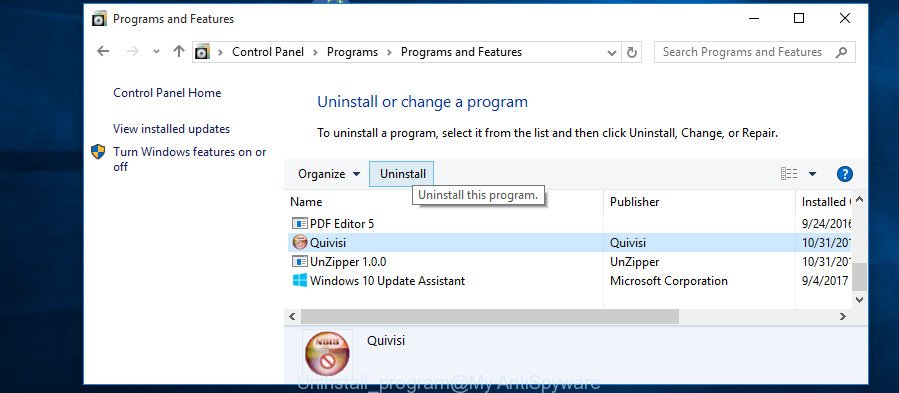
Look around the entire list of apps installed on your computer. Most likely, one of them is the adware which displays misleading “Windows Firewall Warning Alert” pop up on your PC system. Select the dubious program or the application that name is not familiar to you and delete it.
Windows Vista, 7
From the “Start” menu in Windows, choose “Control Panel”. Under the “Programs” icon, select “Uninstall a program”.

Choose the questionable or any unknown applications, then press “Uninstall/Change” button to remove this undesired application from your machine.
Windows XP
Click the “Start” button, select “Control Panel” option. Click on “Add/Remove Programs”.
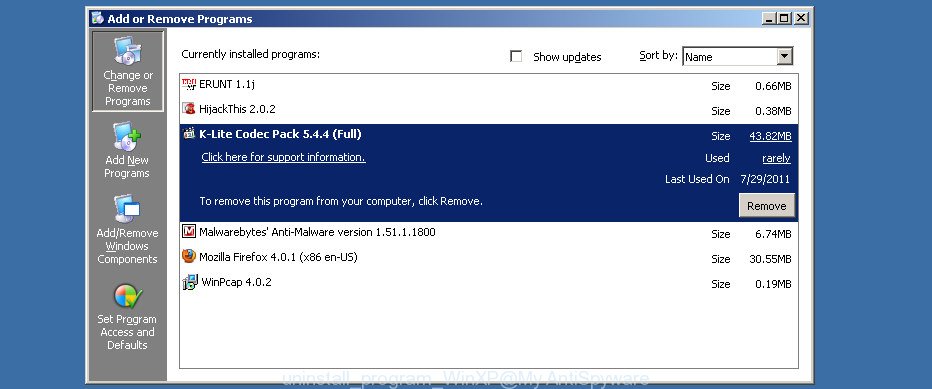
Choose an undesired program, then click “Change/Remove” button. Follow the prompts.
Disinfect the internet browser’s shortcuts to delete “Windows Firewall Warning Alert” redirect
Unfortunately, the adware that causes misleading “Windows Firewall Warning Alert” pop up on your web-browser, can also hijack Windows shortcuts (mostly, your browsers shortcut files), so that the “Windows Firewall Warning Alert” ad web site will be displayed when you start the Edge, FF, IE and Google Chrome or another internet browser.
Right click to a desktop shortcut for your affected web browser. Choose the “Properties” option. It will display the Properties window. Select the “Shortcut” tab here, after that, look at the “Target” field. The adware that causes misleading “Windows Firewall Warning Alert” pop up scam on your browser can rewrite it. If you are seeing something like “…exe http://site.address” then you need to remove “http…” and leave only, depending on the web-browser you are using:
- Google Chrome: chrome.exe
- Opera: opera.exe
- Firefox: firefox.exe
- Internet Explorer: iexplore.exe
Look at the example as shown on the screen below.

Once is complete, click the “OK” button to save the changes. Please repeat this step for internet browser shortcut files that reroutes to an annoying web sites. When you’ve completed, go to next step.
Get rid of “Windows Firewall Warning Alert” pop up warnings from Firefox
If the Firefox web-browser program is hijacked, then resetting its settings can help. The Reset feature is available on all modern version of FF. A reset can fix many issues by restoring FF settings like newtab, homepage and search engine to its default state. It will save your personal information like saved passwords, bookmarks, and open tabs.
Click the Menu button (looks like three horizontal lines), and click the blue Help icon located at the bottom of the drop down menu as on the image below.

A small menu will appear, click the “Troubleshooting Information”. On this page, click “Refresh Firefox” button as on the image below.

Follow the onscreen procedure to restore your Firefox web-browser settings to its original state.
Get rid of “Windows Firewall Warning Alert” popup from Internet Explorer
The Microsoft Internet Explorer reset is great if your browser is hijacked or you have unwanted addo-ons or toolbars on your web browser, which installed by an malicious software.
First, open the Microsoft Internet Explorer, then click ‘gear’ icon ![]() . It will display the Tools drop-down menu on the right part of the web-browser, then press the “Internet Options” as shown in the figure below.
. It will display the Tools drop-down menu on the right part of the web-browser, then press the “Internet Options” as shown in the figure below.

In the “Internet Options” screen, select the “Advanced” tab, then click the “Reset” button. The Internet Explorer will show the “Reset Internet Explorer settings” dialog box. Further, click the “Delete personal settings” check box to select it. Next, press the “Reset” button as displayed in the figure below.

Once the task is done, click “Close” button. Close the Internet Explorer and restart your machine for the changes to take effect. This step will help you to restore your web-browser’s new tab, search provider by default and homepage to default state.
Remove “Windows Firewall Warning Alert” pop up scam from Google Chrome
Use the Reset internet browser tool of the Chrome to reset all its settings such as search engine by default, new tab and start page to original defaults. This is a very useful tool to use, in the case of web-browser redirects to unwanted ad web-sites such as “Windows Firewall Warning Alert”.
Open the Chrome menu by clicking on the button in the form of three horizontal dotes (![]() ). It will open the drop-down menu. Choose More Tools, then click Extensions.
). It will open the drop-down menu. Choose More Tools, then click Extensions.
Carefully browse through the list of installed extensions. If the list has the addon labeled with “Installed by enterprise policy” or “Installed by your administrator”, then complete the following guidance: Remove Google Chrome extensions installed by enterprise policy otherwise, just go to the step below.
Open the Chrome main menu again, click to “Settings” option.

Scroll down to the bottom of the page and click on the “Advanced” link. Now scroll down until the Reset settings section is visible, as on the image below and click the “Reset settings to their original defaults” button.

Confirm your action, click the “Reset” button.
Remove unwanted Scheduled Tasks
If the unwanted “Windows Firewall Warning Alert” site opens automatically on Windows startup or at equal time intervals, then you need to check the Task Scheduler Library and remove all tasks that have been created by unwanted programs.
Press Windows and R keys on the keyboard at the same time. This opens a dialog box that titled with Run. In the text field, type “taskschd.msc” (without the quotes) and click OK. Task Scheduler window opens. In the left-hand side, click “Task Scheduler Library”, as on the image below.
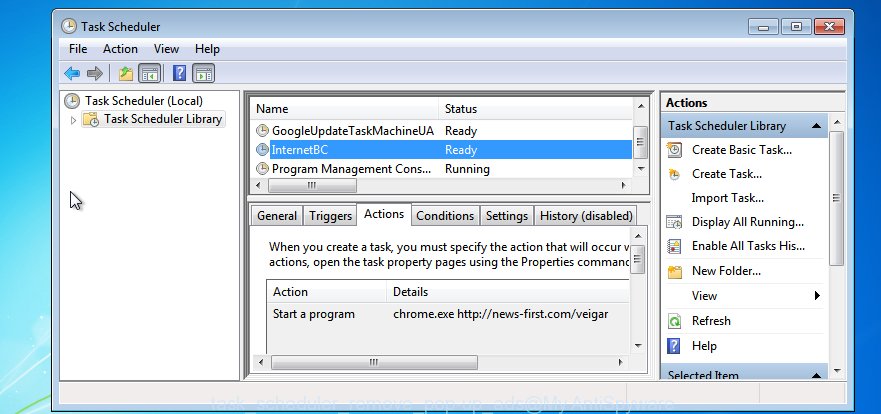
Task scheduler
In the middle part you will see a list of installed tasks. Please choose the first task, its properties will be display just below automatically. Next, press the Actions tab. Pay attention to that it launches on your computer. Found something like “explorer.exe http://site.address” or “chrome.exe http://site.address”, then get rid of this malicious task. If you are not sure that executes the task, check it through a search engine. If it’s a component of the adware, then this task also should be removed.
Having defined the task that you want to remove, then click on it with the right mouse button and select Delete as shown on the image below.

Delete a task
Repeat this step, if you have found a few tasks which have been created by malicious application. Once is done, close the Task Scheduler window.
“Windows Firewall Warning Alert” fake alerts automatic removal
Manual removal tutorial does not always help to completely get rid of the adware, as it’s not easy to identify and get rid of components of ad supported software and all malicious files from hard disk. Therefore, it is recommended that you use malicious software removal tool to completely get rid of “Windows Firewall Warning Alert” off your web browser. Several free malicious software removal tools are currently available that can be used against the ‘ad supported’ software. The optimum solution would be to use Zemana Anti-Malware, MalwareBytes Free and HitmanPro.
Run Zemana Anti-malware to remove “Windows Firewall Warning Alert” pop up
We suggest using the Zemana Anti-malware that are completely clean your system of the adware. The tool is an advanced malicious software removal application created by (c) Zemana lab. It’s able to help you get rid of potentially unwanted applications, hijackers, malicious software, toolbars, ransomware and ‘ad supported’ software which shows misleading “Windows Firewall Warning Alert” pop up warnings on your computer.
Please go to the following link to download Zemana. Save it on your MS Windows desktop or in any other place.
165044 downloads
Author: Zemana Ltd
Category: Security tools
Update: July 16, 2019
After the download is finished, close all windows on your PC. Further, open the install file called Zemana.AntiMalware.Setup. If the “User Account Control” dialog box pops up as shown in the figure below, press the “Yes” button.

It will show the “Setup wizard” that will help you install Zemana Anti Malware (ZAM) on the computer. Follow the prompts and do not make any changes to default settings.

Once installation is done successfully, Zemana Anti-Malware (ZAM) will automatically start and you can see its main window as displayed below.

Next, press the “Scan” button to begin scanning your computer for the ‘ad supported’ software that displays misleading “Windows Firewall Warning Alert” pop up scam on your personal computer. While the Zemana Anti-Malware is checking, you can see count of objects it has identified either as being malicious software.

After Zemana AntiMalware has completed scanning your PC system, a list of all items found is prepared. Review the scan results and then press “Next” button.

The Zemana will remove adware that causes web-browsers to show misleading “Windows Firewall Warning Alert” pop up warnings and add items to the Quarantine. Once the process is finished, you can be prompted to restart your system.
Scan and clean your computer of adware with Hitman Pro
Hitman Pro is a portable program which requires no hard installation to look for and remove adware that causes misleading “Windows Firewall Warning Alert” popup on your web browser. The program itself is small in size (only a few Mb). HitmanPro does not need any drivers and special dlls. It’s probably easier to use than any alternative malicious software removal utilities you have ever tried. HitmanPro works on 64 and 32-bit versions of Windows 10, 8, 7 and XP. It proves that removal utility can be just as effective as the widely known antivirus applications.
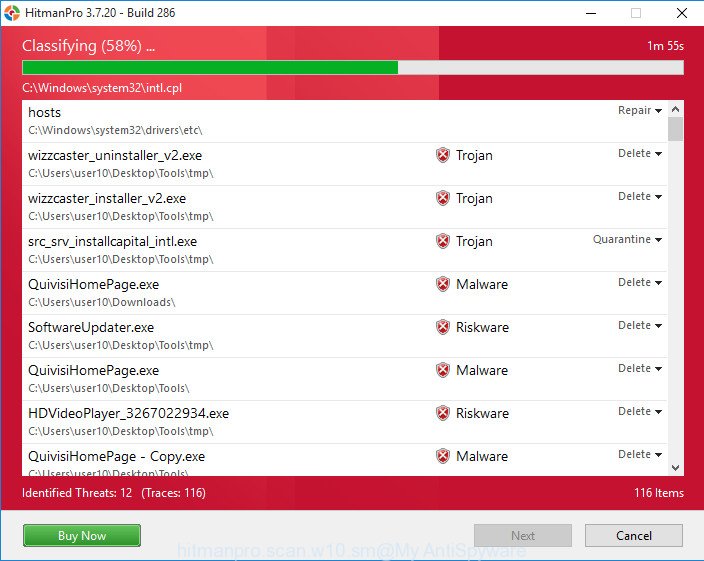
- Visit the following page to download Hitman Pro. Save it on your Windows desktop.
- After downloading is finished, double click the HitmanPro icon. Once this utility is opened, click “Next” button to perform a system scan with this utility for the ‘ad supported’ software that cause misleading “Windows Firewall Warning Alert” popup scam to appear. This task may take quite a while, so please be patient. While the HitmanPro utility is checking, you can see how many objects it has identified as being affected by malware.
- When HitmanPro completes the scan, HitmanPro will show a list of found items. Review the scan results and then click “Next” button. Now click the “Activate free license” button to start the free 30 days trial to remove all malicious software found.
Use Malwarebytes to remove “Windows Firewall Warning Alert” popup warnings
We recommend using the Malwarebytes Free. You can download and install Malwarebytes to find adware and thereby delete “Windows Firewall Warning Alert” pop up from your web browsers. When installed and updated, the free malicious software remover will automatically check and detect all threats present on the machine.
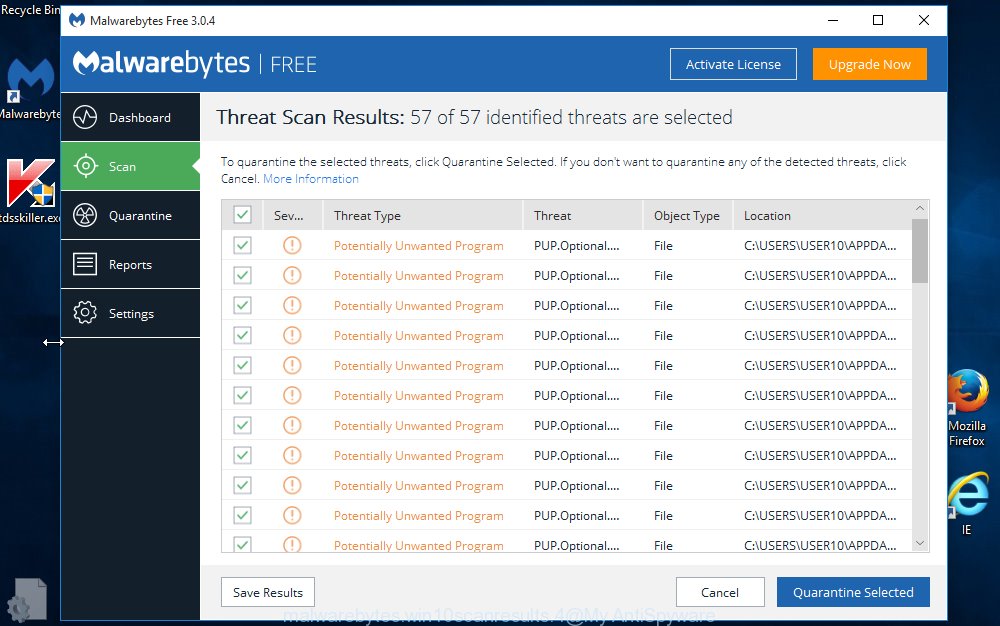
- MalwareBytes AntiMalware (MBAM) can be downloaded from the following link. Save it to your Desktop.
Malwarebytes Anti-malware
327273 downloads
Author: Malwarebytes
Category: Security tools
Update: April 15, 2020
- At the download page, click on the Download button. Your web-browser will show the “Save as” dialog box. Please save it onto your Windows desktop.
- When downloading is done, please close all apps and open windows on your personal computer. Double-click on the icon that’s named mb3-setup.
- This will run the “Setup wizard” of MalwareBytes Anti Malware (MBAM) onto your computer. Follow the prompts and don’t make any changes to default settings.
- When the Setup wizard has finished installing, the MalwareBytes Anti-Malware (MBAM) will run and display the main window.
- Further, press the “Scan Now” button to detect adware that created to show misleading “Windows Firewall Warning Alert” fake alerts within your web-browser. While the MalwareBytes Free program is checking, you can see how many objects it has identified as threat.
- After finished, MalwareBytes will show you the results.
- All detected threats will be marked. You can delete them all by simply click the “Quarantine Selected” button. Once disinfection is complete, you may be prompted to restart the PC.
- Close the AntiMalware and continue with the next step.
Video instruction, which reveals in detail the steps above.
Stop “Windows Firewall Warning Alert” popup warnings and other unwanted pages
We recommend to install an ad blocker program that can stop “Windows Firewall Warning Alert” and other intrusive pages. The ad-blocker tool such as AdGuard is a application that basically removes advertising from the Internet and blocks access to malicious webpages. Moreover, security experts says that using adblocker programs is necessary to stay safe when surfing the Web.
Download AdGuard from the link below.
26902 downloads
Version: 6.4
Author: © Adguard
Category: Security tools
Update: November 15, 2018
After downloading it, start the downloaded file. You will see the “Setup Wizard” screen as displayed in the figure below.

Follow the prompts. After the install is finished, you will see a window as shown on the screen below.

You can press “Skip” to close the setup application and use the default settings, or click “Get Started” button to see an quick tutorial which will assist you get to know AdGuard better.
In most cases, the default settings are enough and you do not need to change anything. Each time, when you start your system, AdGuard will start automatically and block pop-ups, pages like “Windows Firewall Warning Alert”, as well as other harmful or misleading web-pages. For an overview of all the features of the program, or to change its settings you can simply double-click on the AdGuard icon, that is located on your desktop.
Where the “Windows Firewall Warning Alert” popup comes from
In most cases, the ad-supported software come bundled with the installation packages from a free hosting and file sharing web sites. So, install a freeware is a a good chance that you will find a bundled adware. If you don’t know how to avoid it, then use a simple trick. During the installation, choose the Custom or Advanced installation method. Next, click ‘Decline’ button and clear all checkboxes on offers that ask you to install bundled software. Moreover, please carefully read Term of use and User agreement before installing any software or otherwise you can end up with another unwanted program on your computer such as this adware that causes browsers to display misleading “Windows Firewall Warning Alert” pop-up scam.
To sum up
After completing the steps shown above, your computer should be clean from ad supported software that causes internet browsers to open misleading “Windows Firewall Warning Alert” fake alerts and other malware. The Edge, Google Chrome, Firefox and Internet Explorer will no longer redirect you to various annoying web-sites similar to “Windows Firewall Warning Alert”. Unfortunately, if the tutorial does not help you, then you have caught a new ‘ad supported’ software, and then the best way – ask for help in our Spyware/Malware removal forum.




















